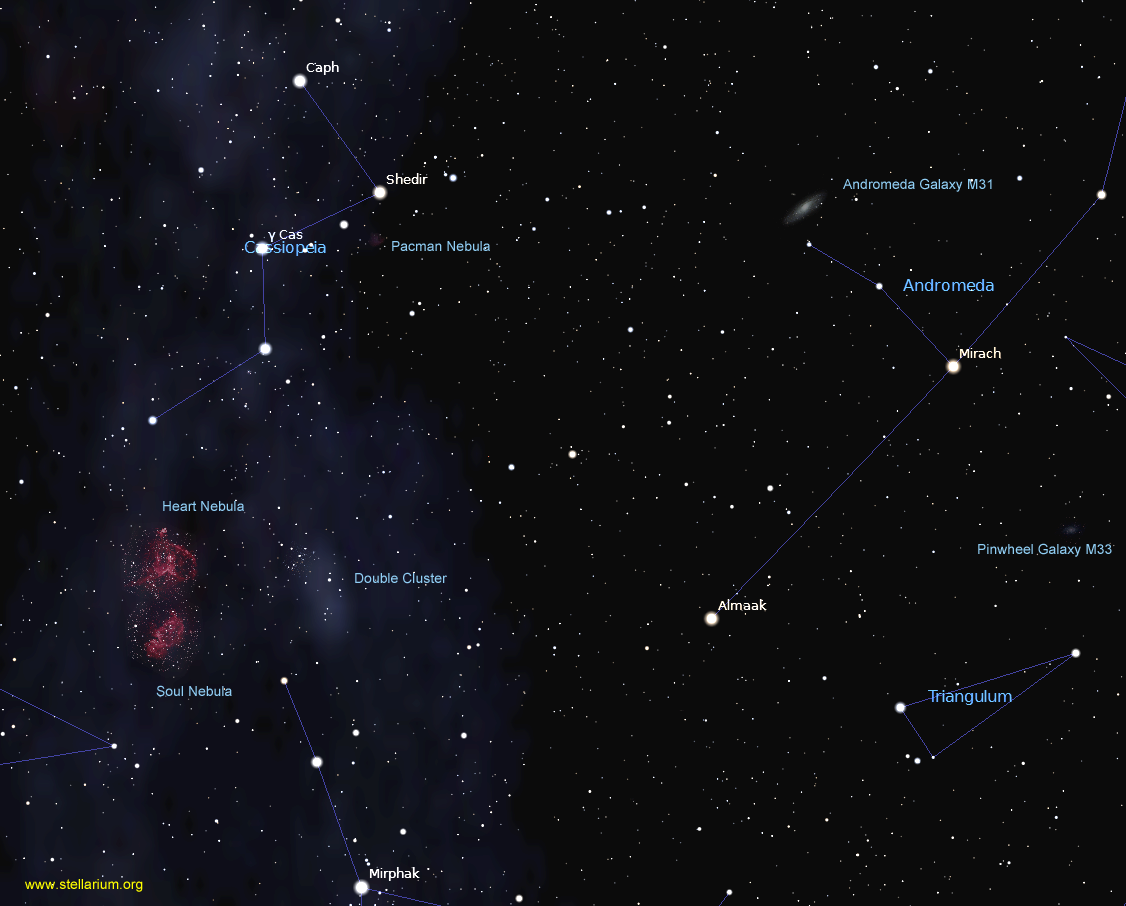Cassiopeia – The Queen
One of the most familiar and recognizable constellations is Cassiopeia the Queen. In mythology, she is the wicked mother who along with King Cepheus sacrificed their daughter Andromeda to the sea monster – Cetus. The “W” in the sky is your guidepost to the Double Cluster in the constellation Perseus, our hero in this story. In a low power eyepiece, two distinct open clusters greet you. The combined light of both members equals that of a fourth magnitude star. Keep in mind this is stretched over a wide area. They are estimated to be 7,100 and 7,400 light-years (ly) from us. Viewing the Double Cluster under very dark conditions is like seeing diamonds on black velvet.
A very large target for astrophotographers is the Heart and Soul Nebulas. Located about 4.5 degrees east of the Double Cluster, we first come across the Heart Nebula. Catalogued as IC 1805 it is located some 6,500 ly away and with dimensions of 5 by 5 degrees. Radiation from a young cluster of stars called Melotte 15 at its centre causes the red glow. Next to the Heart, the Soul Nebula (IC 1848) also lies at the same distance. It measures 5 by 2.5 degrees and has a few open star clusters embedded in its structure.

One and three-quarter degrees from the Alpha star named Shedar is NGC281, the Pacman Nebula. Measuring the size of the full moon, this emission nebula has a reddish glow due to active hydrogen molecules. NGC281 is fairly bright and can be glimpsed in binoculars under superb dark conditions. The Pacman contains several Bok Globules. These are dense regions of dust and gas that might form stars.
Earlier this year we had the good fortune of seeing all five visible in the night sky. But that is now reduced to just Mars and Saturn. The ringed planet is close to the horizon and disappears from view by 7:30 local time. Mars is dimming and can still be observed until midnight. Both Venus and Spica will be glimpsed in the eastern sky before dawn starting the second half of November.
The annual Leonid meteor shower peaks on the night of November 17-18. The parent Comet Tempel-Tuttle orbits the sun every 33 years and makes its return in 2031. This is a moderate shower that only produces 15-20 meteors per hour and is far from the meteor storm in the late 1990s. The best time to observe is after moonset and before dawn.
Comet 46P/Wirthaner is moving north through Fornax and on its way for a great show mid-December. The beginning of November sees the comet around magnitude 7.2 but could reach as bright as third magnitude next month. More to come about comet Wirtanen in next month’s article.
Most places will see Daylight Saving Time ends as the clocks move back one hour on November 4 at 2 a.m. Also, remember to compensate when using Universal Time. New Moon occurs on the 7th while the full Beaver Moon occurs just after midnight eastern time on the 23rd.
Till next month – clear skies everyone
Gary Boyle
